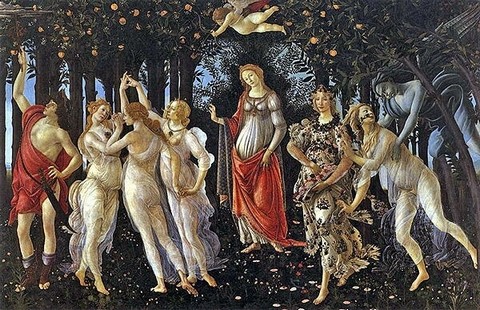- HOME > 芸術の特徴(カトリック)
芸術の特徴(カトリック)
カトリック芸術は、その華やかさが大きな特徴であり、見る者を圧倒します。
簡素な東方正教会美術とは対照的で、ここにも教派による美術の捉え方の違いを
見ることができるでしょう。
カトリック芸術が大成するに至る原動力となったのは、フィレンツェで起きた
古典芸術復興の運動、「ルネサンス」(後述)にあります。
ルネサンスそのものは、キリスト教芸術の発展のためにあったのではありませんが、
この時期に、多くの「天才」と呼ばれる芸術家が、新しい表現方法を試みるようになり、
キリスト教芸術にも反映させていきました。
それが「写実主義」と呼ばれる表現方法です。
また、色彩はより立体性を追求するに従って微妙かつ豊かになりました。
背景も、よりリアルな表現が求められるようになり、徐々に華やかになっていき、
かつての「金色一色」とは異なる表現になっていったのです。
その芸術志向は、かの有名な、レオナルド・ダ・ヴィンチやミケランジェロ、
ボッティチェリの絵画にも多く見受けられます。
■ボッティチェリ「春」

彼らは決して宗教画家ではなく、あくまでルネサンス芸術の担い手でしたが、
宗教画を描いても、ほかの絵画同様に、新しく得た表現方法として、写実や立体を多く
用いています。
こうして、天才たちの活躍にも助けられて、カトリック芸術はどんどんその豪華さに
凄みを増し、人々を圧倒するまでになっていったのです。
The Feature of Art (Catholicism)
The feature of Catholic art is splendor, overwhelming the viewers.
In contrast to the simple Eastern Orthodox art, the differences in ways of viewing arts depending on the denomination can be seen.
The motive force for Catholic art to flower is in the Renaissance (see below), the revival movement of classical culture in Florence.
Renaissance itself was not for the development of Christian art but at this time many artists called genius began to try new techniques of expression, which had been reflected in Christian art as well.
It is the technique of expression called realism.
In addition, as the color had pursued three-dimensionality, it became subtle and rich.
As the realistic expression was required on the background, it gradually became gorgeous and different from the previous expression with golden color.
This direction of art can be also found in works of notable Leonardo da Vinci, Michelangelo, and Botticelli.
They were never religious artists, but just the leaders of the Renaissance art. On the other hand, when they made religious arts, they often used many realistic and three-dimensional techniques as new techniques of expression, like they did on other works.
Thus, with the activities of the geniuses, the Catholic art became gorgeous steadily and overwhelming for people.